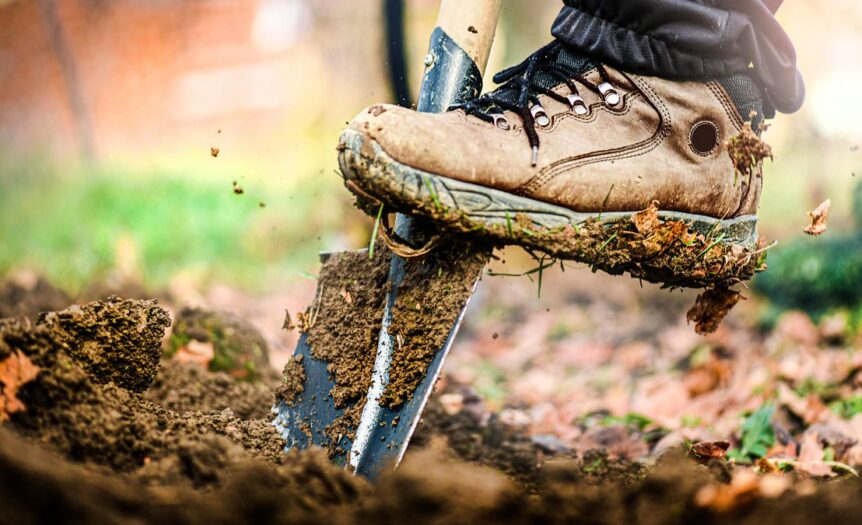Ready to start digging in your backyard? Hold on there. While digging a hole takes no special skill or training, there’s a right way to do it and a whole lot of wrong ways. Done wrong, digging a hole in your backyard can lead to damage, injury, lost service, and more. Consider reading and following these four tips to safely dig a hole in your backyard before you grab your shovel. You could save yourself a tremendous amount of time and hassle.
What Lies Below?
Finding out what you might run into along the way is one of the biggest considerations when digging a hole. Mostly, you’ll encounter more dirt, but sometimes there are other things underground that can cause havoc should you clip or cut them with your shovel. Check out your property’s plot map to see where the utility lines, pipes, or similar objects run and determine where you should dig. Even better, call the electricity, gas, cable, and other companies in your community and ask them to identify where such things might be in your yard. Often, these companies will post signs nearby with their number, requesting that you call before you dig. Do it, or face the prospect of no utilities, your neighbors’ wrath, or an explosion or electrocution. Also, consider renting or hiring a vacuum excavator, or potholer, to suck up dirt, revealing cables, pipes, and more.
Tool Time
Sometimes, you need more than a shovel or spade to dig a proper hole. You’ll need a clamshell digger if you’re digging post holes. Simply thrust this tool into the ground and use it to make neat cylindrical holes. Having a steel digging bar nearby can be handy if you’re working on rocky soil. It can loosen soil and dislodge large stones. Use a pointed spade to start a hole but employ a sharp-edged tile shovel to cut through hard-packed dirt. Use a powered reciprocating saw if you encounter roots. This tool will easily cut them up.
Whether the Weather
You probably weren’t planning to dig on a stormy day, but what if the stormy day happens when you aren’t expecting it? Watch the weather. Reschedule your dig if it’s going to rain. Rain, naturally, makes your job that much harder, but it also increases the chance of collapsing your hole. That’s especially bad if you’re standing in it at the time. Cold weather is also really no time to dig. Remember, the ground can freeze, which can damage equipment. Save your dig for a warm day.
Well-Dressed
Here’s the last of our four tips to safely dig a hole in your backyard: dressing to dig a hole. Keep things loose on hotter days so you don’t risk overheating and experiencing heat stroke or heat exhaustion. Wear protective footwear. A strong pair of boots should suffice, but steel-toed boots with tarsal plates provide extra protection. Gloves are a necessity. Pick ones with a good grip to protect your hands from developing blisters. Finally, goggles and safety glasses can protect your eyes from anything that springs up as you dig.










 Deering Estate
Deering Estate
 Massage Envy South Miami
Massage Envy South Miami
 Calla Blow Dry
Calla Blow Dry
 My Derma Clinic
My Derma Clinic
 Sushi Maki
Sushi Maki
 Sports Grill
Sports Grill
 The Healthy Kitchen
The Healthy Kitchen
 Golden Rule Seafood
Golden Rule Seafood
 Malanga Cuban Café
Malanga Cuban Café

 Kathleen Ballard
Kathleen Ballard
 Panter, Panter & Sampedro
Panter, Panter & Sampedro
 Vintage Liquors
Vintage Liquors
 The Dog from Ipanema
The Dog from Ipanema
 Rubinstein Family Chiropractic
Rubinstein Family Chiropractic
 Your Pet’s Best
Your Pet’s Best
 Indigo Republic
Indigo Republic




 ATR Luxury Homes
ATR Luxury Homes


 2112 Design Studio
2112 Design Studio
 Hamilton Fox & Company
Hamilton Fox & Company
 Creative Design Services
Creative Design Services
 Best Pest Professionals
Best Pest Professionals
 HD Tree Services
HD Tree Services
 Trinity Air Conditioning Company
Trinity Air Conditioning Company
 Cisca Construction & Development
Cisca Construction & Development
 Mosquito Joe
Mosquito Joe
 Cutler Bay Solar Solutions
Cutler Bay Solar Solutions


 Miami Royal Ballet & Dance
Miami Royal Ballet & Dance
 Christopher Columbus
Christopher Columbus
 Pineview Preschools
Pineview Preschools
 Westminster
Westminster
 Carrollton
Carrollton
 Lil’ Jungle
Lil’ Jungle
 Frost Science Museum
Frost Science Museum
 Palmer Trinity School
Palmer Trinity School
 South Florida Music
South Florida Music
 Pinecrest Orthodontics
Pinecrest Orthodontics
 Dr. Bob Pediatric Dentist
Dr. Bob Pediatric Dentist
 d.pediatrics
d.pediatrics
 South Miami Women’s Health
South Miami Women’s Health

 The Spot Barbershop
The Spot Barbershop
 My Derma Clinic
My Derma Clinic




 Miami Dance Project
Miami Dance Project

 Rubinstein Family Chiropractic
Rubinstein Family Chiropractic
 Indigo Republic
Indigo Republic

 Safes Universe
Safes Universe
 Vintage Liquors
Vintage Liquors
 Evenings Delight
Evenings Delight





 Atchana’s Homegrown Thai
Atchana’s Homegrown Thai
 Baptist Health South Florida
Baptist Health South Florida

 Laser Eye Center of Miami
Laser Eye Center of Miami
 Visiting Angels
Visiting Angels
 OpusCare of South Florida
OpusCare of South Florida

 Your Pet’s Best
Your Pet’s Best





 HD Tree Services
HD Tree Services
 Hamilton Fox & Company
Hamilton Fox & Company


 Creative Design Services
Creative Design Services